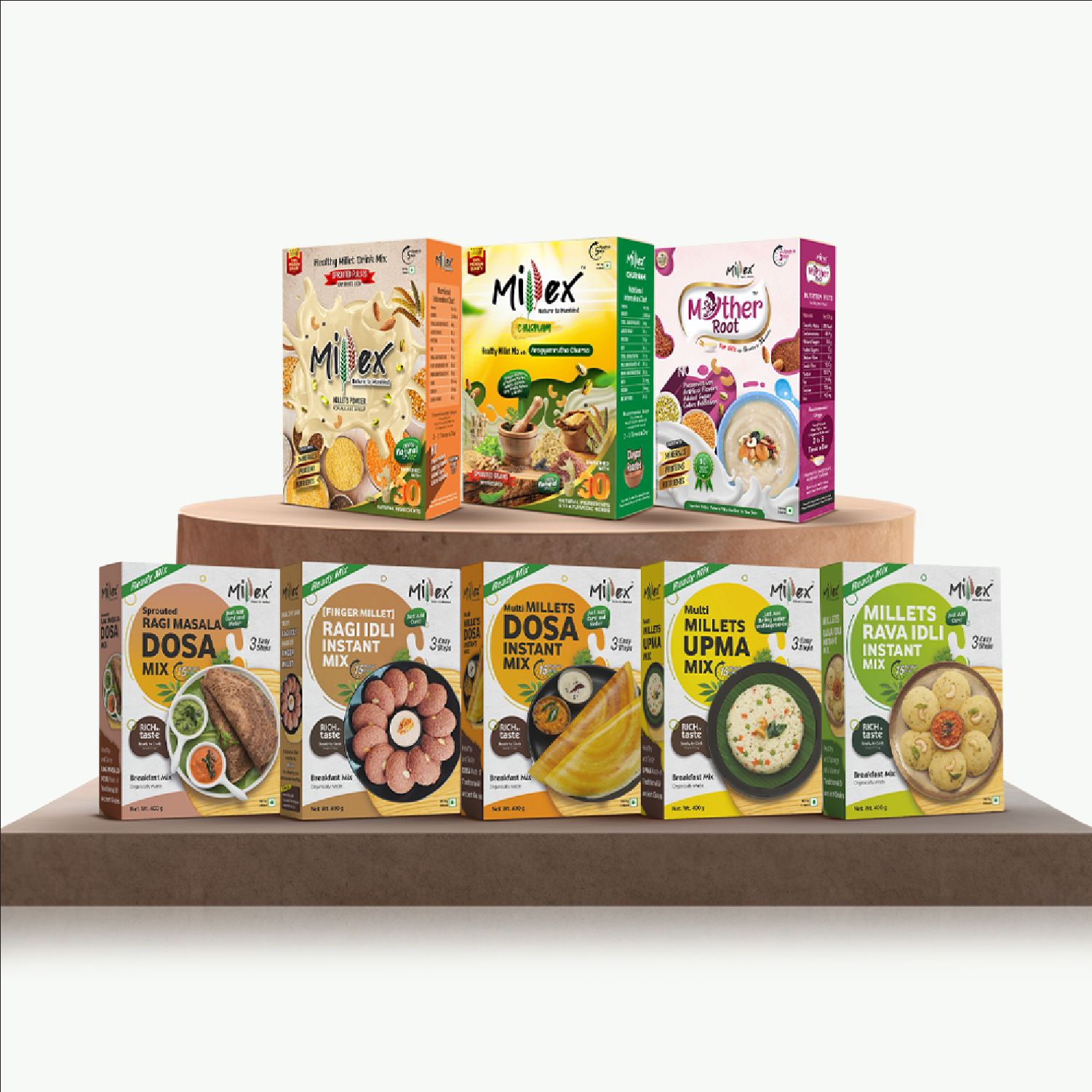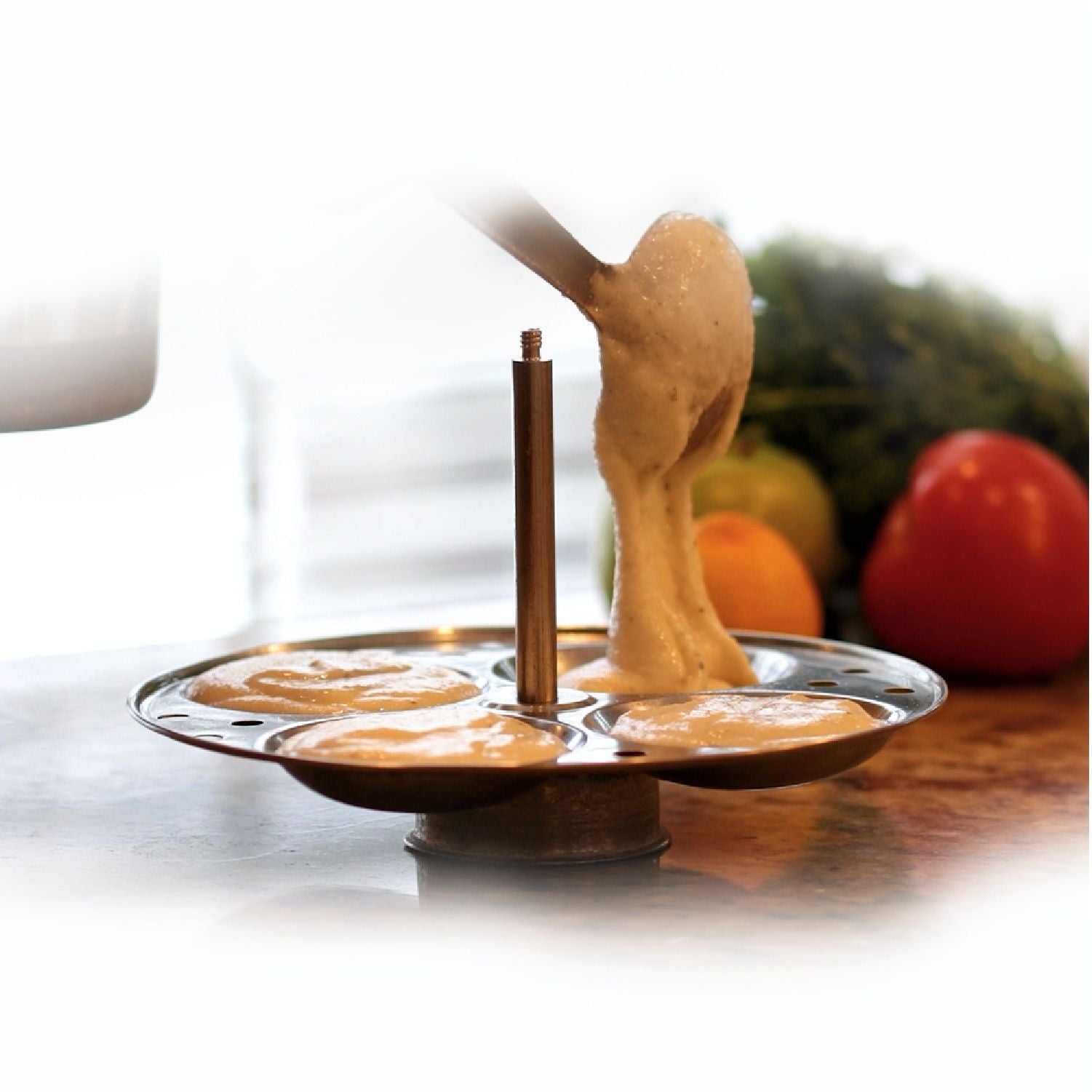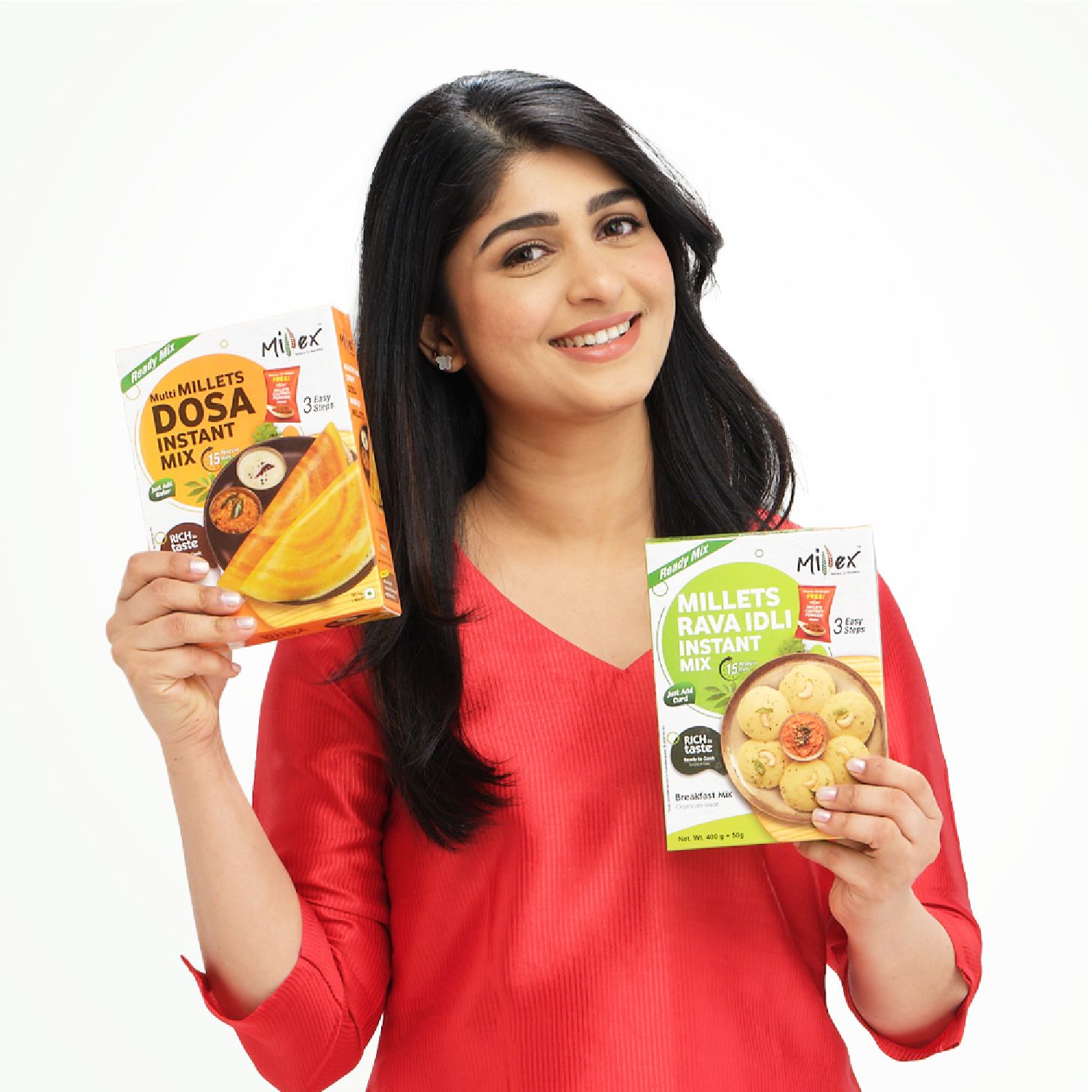List of low-carb millets and low-carb grains:
1. Sorghum
2. Barnyard
3. Foxtail
4. Little Millet
5. Kodo millet
6. Browntop Millet
7. Proso Millet
7. Finger millet
8. Pearl Millet
9 Best Low-Carb Millets You Need to Try Today
The rise in low-carbohydrate diets over the past few decades has made all low-carb foods, including low-carb millets, become increasingly popular. A tasty and nutritious culinary journey starts with millet, an ancient grain that has long been a staple in Asian and African nations. They have a lot of nutritional content and are ready to change your diet as they are a good low-carb alternative for usual grains.
These amazing grains are packed full of vital vitamins and minerals, fiber, and protein. Because of their low carbohydrate content, they are an excellent option for effective weight management besides helping to maintain stable blood sugar levels. Find about low-carbohydrate millets included in Millex Millet Health Mix which has lot of health benefits:
Sorghum
Sorghum bicolor L. is the scientific name for sorghum, a crop belonging to the Gramineae family that is abundant in carbohydrates. This is the fifth most produced crop in the world. Sorghum is available in several varieties, such as white, black, red, etc. Known as "The King of Millets," it is a staple crop for millions of people living in semi-arid regions.
The primary component is starch, which breaks down more slowly than other grains and has a low digestibility of fat and protein. Carbohydrates make up the majority of sorghum's calories. Naturally occurring starches, of the stronger, slower-digesting complex structure, make up the remaining carbohydrates in sorghum.
Eating sorghum improved blood glucose responses, according to the systematic analysis that linked the grain to decreased inflammation. People who have diabetes or prediabetes may find this to be excellent news.
Barnyard
Rich in protein, calcium, iron, minerals, and vitamin B complex, Barnyard millet, also called Sanwa rice, is a popular grain in India. For people with gluten sensitivities, type II diabetes, and cardiovascular illnesses, it is especially beneficial because it is low in carbohydrates and gluten-free. The health-conscious millennial generation favors the Barnyard millet as it is the least carbohydrate-containing, gluten-free, and has the highest energy value of all the millets.
Barnyard millets, when eaten raw, provide 75 calories, 68% carbohydrates,1.5g of protein, and less than 400 kcal/100 gm , making them a great choice for people on a diet. Millets' strong amylase retro gradation of their carbs promotes the development of larger concentrations of resistant starch. Therefore, it is recommended for individuals who have diabetes and cardiovascular disease.
Foxtail
The distinctive protein composition of foxtail millet (Setaria italica L.), an annual grass species, results in seeds with health-promoting qualities as it has a high concentration of important amino acids. Even under unfavorable weather, this millet can thrive. These are globally climate-friendly and high-nutrient crops. Owing to their remarkable nutritional content and low carbohydrates, foxtail millets provide a number of health benefits.
They include high levels of protein, minerals, dietary fiber, and carbs. They are appropriate for people who have a gluten sensitivity because they are gluten-free. The high fiber content facilitates intestinal health and helps with digestion. Foxtail millets are an excellent option for people who are controlling their blood sugar levels due to their low glycemic index.
Little Millet
Little millet is a gluten-free cereal grain that has been grown for centuries in India and other Asian and African countries. It belongs to the grass family of plants and is known by its scientific name, Panicum sumatrense. The tiny, rounded, light yellow seeds have a subtle, enjoyable nutty flavor. This resilient crop's capacity to flourish in a variety of soil types and temperatures demonstrates its flexibility.
Rich in antioxidants, little millet boosts immunity and shields against a range of illnesses and infections. It's loaded with vital minerals, such as magnesium, which is needed to keep bones, muscles, and nerves functioning properly.
Low-carbohydrate feature of little millet is an added advantage. This millet is safe for those who are sensitive to or intolerant to gluten because it is gluten-free. Also, its mild flavor compliments a variety of savory and sweet dishes, such as pilafs, baked goods, and porridges.
Kodo millet
Kodo millet, scientifically known as Paspalum scrobiculatum, is an important crop grown in India. It is packed with multiple nutrients that are good for a healthy body. Due to its high carbohydrate content and lack of gluten, kodo millet is beneficial for people who are gluten intolerant.
Due to its high antioxidant, fiber, and fat content, this food item has become more popular in the realm of healthy diets. You will be amazed by the amazing qualities of this millet and desire to use it to improve your health. The high antioxidant and fiber content of kodo millets makes them an excellent choice for lowering LDL (bad) cholesterol while preventing plaque accumulation in the arteries.
Also, it has prebiotic fiber, potassium, and magnesium, all of which strengthen and protect the heart. You can prevent high blood pressure and other chronic diseases by include these millets in your diet.
Browntop Millet
Scientistically known as Brachiaria ramosa, browntop millet is growing in popularity because of its outstanding nutritional profile and capacity to withstand hot and dry circumstances with little water. It is mostly grown in the rain-fed regions of Karnataka, Andhra Pradesh, and some areas of North-Central India.
Brown top millet is an absolute richest source of nutrients that are essential to optimum health and wellbeing. These little nuts can provide you with your recommended daily intake of healthful fats, carbohydrates, proteins, and dietary fiber. Additionally, they contain an abundance of vital elements such as calcium, iron, phosphorus, potassium, magnesium, manganese, copper, sodium, and zinc.
Brown top millet delays the emptying of the stomach and gives you a feeling of fullness, making it a great option if you have diabetes and are trying to control your diet. Carbohydrate content and brown top millet's glycemic index help regulate blood sugar and reduce appetite.
Proso Millet
India is a major producer and consumer of proso millet, also known as white millet, hog millet, or Kashif millet. With a rigid, glossy hull that securely encloses the seeds as it is shed, it resembles an egg-shaped fertile floret. Its unique features are responsible for proso millet's health advantages.
Not only is it free of gluten, but it also has an abundance of lipids and carbohydrates, making it an excellent source of energy. Its high protein content sets it apart from other millet available on the market. In breads, salads, and soups, it is king. Also, it is the best option for treating rashes, abscesses, and cuts.
Finger millet
In many parts of India, finger millet, also referred to as "ragi," is a nutritious cereal grain. Finger millet crops can withstand both alkaline and slightly acidic soils, and they are resistant to drought.
In fact, ragi is a healthy, high-fiber Indian cuisine that can replace other common cereal and grain crops like rice, wheat, or barley in the Indian diet. It has the advantage of being a very uncommon plant source of important essential amino acids, which can be used to supplement vegetarian and vegan diets.
Finger millet has low-carbohydrate content and contain a number of minerals, some, such as iron, calcium, potassium, dietary fibers, and amino acids. So eating ragi-based morning items, such as ragi upma or ragi parathas, stimulates the digestive juices and guarantees full absorption of the nutrients in ragi.
Pearl Millet
Bajra, also referred to as pearl millet, is a cereal grain that is very nutritious and easily digested. It is a healthy choice for those with celiac disease and gluten allergies because it is non-glutinous.
Carbohydrates, vital amino acids, antioxidants, thiamine, riboflavin, folic acid, niacin, beta carotene, and minerals like iron, phosphorus, magnesium, and zinc are all rich in them. One of the most significant benefits of pearl millet, or bajra, is that it can help with weight loss.
Therefore, include it in your diet could be advantageous if weight loss is your goal. The protein in this millet helps in tissue repair and muscular growth. Given its high protein content, it's a fantastic low-carb substitute for vegans.
Bajra, or pearl millet, comes in a variety of forms that are suitable for everyday food intake. Use it as flour for millet dosas or flatbreads, as well as processed grains for porridge, ready-to-eat snacks like millet or multigrain biscuits, and processed grains for poha or upma for breakfast.
Final thoughts
Millets are the best foods with low carbohydrates. If you are looking for above mentioned millets in single package then, Millex Millet Health Mix is for you. Apart from millets it also includes cereals, seeds, pulses, dry fruits, nuts, and spices. Consistent exercise and a well-balanced diet along with Millex Millet Health Mix keeps you fit. Prepare to shed those excess pounds and keep you healthy with the help of Millex Millet Health Mix.
The best time to eat millet for weight loss is during balanced meals like breakfast or dinner. A healthy routine starts with wholesome grains
which millet is low in carbohydrates?
Barnyard millet is one of the millets low in carbohydrates, making it a suitable option for those looking to reduce their carb intake. It typically contains about 66 grams of carbohydrates per 100 grams, which is lower than other millets. Additionally, barnyard millet is high in fiber, helping promote satiety and manage blood sugar levels. Its nutritional profile makes it a great choice for individuals following low-carb or ketogenic diets.
1. What are some low-carb grains?
- Low-carb grains include quinoa, millet, bulgur, and wild rice, but they still contain some carbohydrates. Alternatives like chia seeds and flaxseeds are even lower in carbs.
2. Are there millets without carbohydrates?
- All millets contain carbohydrates, but they have a low glycemic index, making them ideal for maintaining blood sugar levels. There are no completely carbohydrate-free millets.
3. Can millets be included in a low-carb diet?
- Yes, millets like barnyard millet can be included in moderation due to their high fiber content, which slows down the absorption of carbohydrates.
4. What makes millets better than regular grains for low-carb diets?
- Millets are higher in fiber and protein and have a low glycemic index compared to traditional grains like rice or wheat, helping in blood sugar regulation.
5. How can I reduce the carb impact of millets?
- Pair millets with protein-rich or high-fiber foods like legumes, vegetables, or nuts to balance your meal.
6. Are there any completely carb-free grains?
- Grains are inherently carbohydrate-rich. For carb-free options, consider alternatives like almond flour or coconut flour.
7. Why are millets suitable for diabetics?
- Millets have a low glycemic index, meaning they release glucose slowly into the bloodstream, preventing sudden spikes in blood sugar levels.
8. How do barnyard millet and foxtail millet compare in carbs?
- Barnyard millet typically has fewer carbs than foxtail millet, making it a better choice for strict low-carb diets.
9. Can millets help in weight loss despite their carb content?
- Yes, millets are rich in fiber and protein, which promote satiety and prevent overeating, aiding in weight loss even with moderate carb intake.






